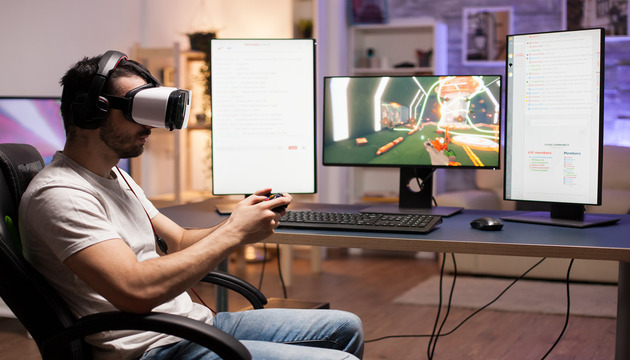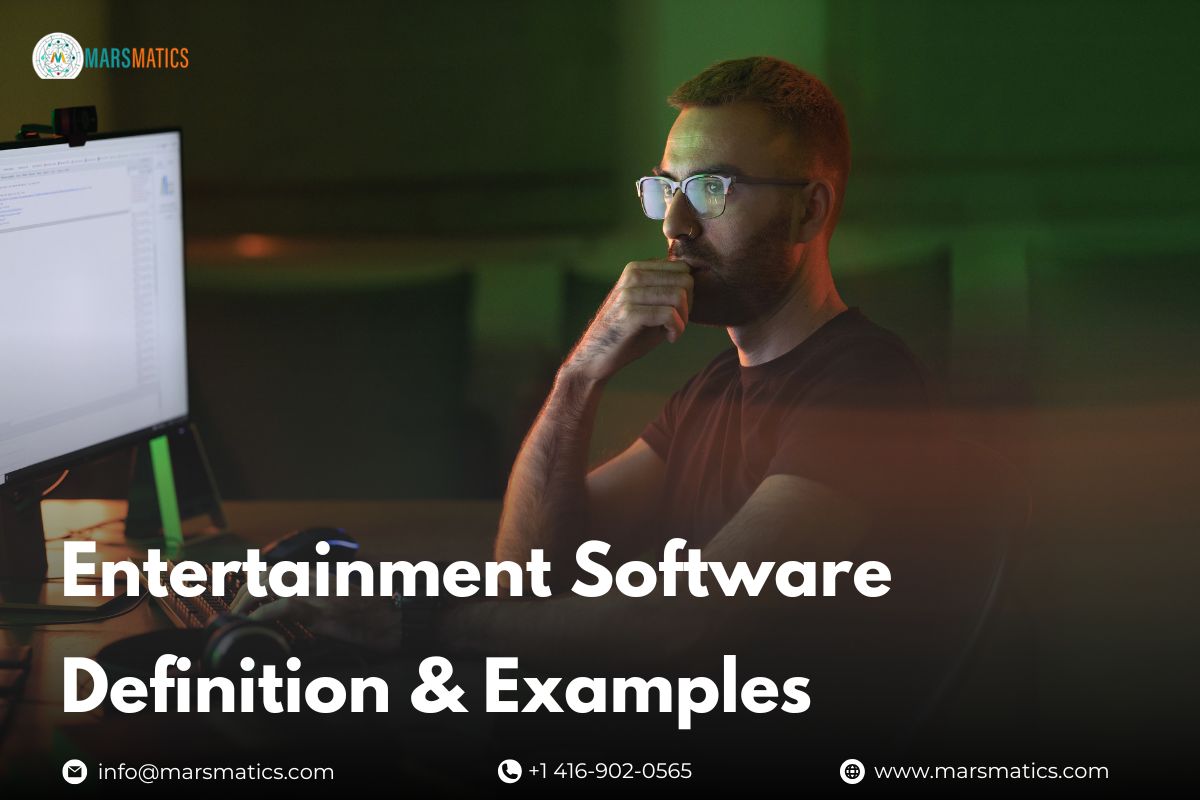Entertainment Software Definition & Examples
Have you ever paused during a thrilling gaming session or while binge-watching your favorite series to think, ‘What magic makes this possible?’ Behind every moment of digital delight from the immersive realms of video games to the dynamic worlds of streaming services stands a powerful force: entertainment software.
In this blog, we’re going to explore what entertainment software really is, some standout examples, and discuss how it enriches our daily lives. Whether you’re deeply embedded in the tech world or just someone who loves diving into these digital escapes, you’ll discover fascinating insights into the tools that bring so much joy and connection to our lives.
What is Entertainment Software?
Entertainment software is essentially the programs and applications designed to entertain users. It includes everything from video games and educational apps to music and video streaming services.
These pieces of software are crafted to be interactive, engaging, and fun, offering a wide range of entertainment options on various devices like computers, smartphones, and consoles. The main goal? To provide enjoyment and, often, a way to connect with others online, enriching our leisure time and giving us new ways to learn and explore.
Types of Entertainment Software:
Here are some of the most common types of entertainment software
Also Read: What is application software with some common examples
Video Games:
Video games are a dynamic form of entertainment software that immerses players in interactive digital environments. They range from simple puzzles suitable for casual gamers to complex simulations designed for seasoned players. As players navigate through these games, they encounter carefully crafted challenges that test their skills and decision-making abilities.
Common Technologies Used in Video Games:
- Game Engines like Unity and Unreal Engine: These platforms provide the tools necessary for game development, from rendering graphics to simulating physics.
- Artificial Intelligence (AI): AI is often used to enhance non-player character (NPC) behavior, making them react intelligently to player actions and changes in the environment.
- Virtual Reality (VR) and Augmented Reality (AR): VR immerses users in a fully digital environment, while AR overlays digital elements onto the real world, both adding a layer of depth and interaction that enhances the gaming experience.
- Cloud Gaming Technology: This allows games to be run on powerful servers and streamed directly to devices, reducing the need for expensive hardware.

Multimedia Software:
Multimedia software is designed to handle various types of media content such as text, graphics, video, and sound all within a single interface. This kind of software is important in creating and editing rich, interactive content that enhances digital entertainment experiences. It can range from video editing programs that let users create their own films to digital audio workstations used by musicians to compose music.
Examples of Multimedia Software:
- Adobe Premiere Pro
- Final Cut Pro
- Blender
- CorelDRAW
Educational Entertainment Software (Edutainment):
Edutainment is a blend of education and entertainment, designed to make learning fun and engaging through interactive software. This type of software combines the thrill of gaming with educational content, helping users, especially children, to learn new skills and knowledge in an enjoyable way. Common examples include language learning apps, math games, and virtual science labs.
Examples:
- Duolingo – A language learning app that uses game-like mechanics to encourage regular practice of numerous languages, including Spanish, French, and Japanese.
- LeapFrog – Provides a variety of handheld educational games for young children, focusing on literacy, math, and science.
- Scratch – Developed by MIT, this free programming tool teaches children and beginners to create their own games and animations using simple coding blocks.
- Rosetta Stone – An immersive language learning software that uses images, text, and sound to teach languages through natural immersion methods.
- Adventure Academy – A multiplayer online game for children that provides learning activities in a virtual world setting.
- BrainPOP – Features animated educational videos, quizzes, and interactive activities covering a wide range of topics for K-12.

How Entertainment Software is Developed?
Developing entertainment software is a complex, creative process that involves multiple steps. Here’s a simplified overview:
Concept and Planning:
- Idea Generation: Begins with an idea for a new game, app, or multimedia project.
- Defining Objectives: Set clear goals regarding what the software will accomplish and who the target audience is.
Design:
- Storyboarding and Prototyping: Create visual sketches and basic versions of the software to map out the user experience and functionality.
- Art and Audio Production: Design characters, environments, and background music to enhance the appeal.
Software Development:
- Coding and Programming: Use programming languages (like C++, Python, or Java) to build the software’s architecture and functionality.
- Engine and Tool Implementation: Integrate game engines (like Unity or Unreal Engine) for more complex projects.
Testing:
- Debugging: Systematically fix any issues in the code to ensure the software runs smoothly.
- Quality Assurance (QA): Test the software in various scenarios to make sure it meets the original design specifications and is free of bugs.
Launch and Post-Release:
- Deployment: Release the software to the public via platforms suitable for the content (like Steam for games or App Store for mobile apps).
- Updates and Maintenance: Continuously update the software to add new features, fix bugs, and adjust based on user feedback.
The Role of Software Developers:
Software developers are central to the creation of entertainment software, contributing at every stage from concept to launch. They work on everything from coding and testing to problem-solving and maintenance, ensuring the software functions smoothly and meets both user needs and business objectives.
Key Technologies Used in Entertainment Softwares:
The development of entertainment software depends on a variety of advanced technologies. These include programming languages like C++ and Python, game engines such as Unity and Unreal Engine, and tools for graphics and sound production like Blender and Adobe Creative Suite. These technologies help developers create more immersive and interactive experiences in games and other digital entertainment formats.
The Business of Entertainment Software:
| Aspect | Details | Source |
| Revenue Growth and Market Dynamics | Global entertainment and media industry revenues are rising, with advertising revenue expected to reach $1 trillion by 2026. Growth is driven by digital advertising, streaming, and gaming. | PwC Global Entertainment & Media Outlook 2024-28 |
| Technological Advancements and AI Integration | Generative AI is becoming more prevalent, enhancing creative capabilities and helping manage costs. This technology is transforming content creation and production processes. | PwC Global Entertainment & Media Outlook 2024-28, KPMG Insights for the Media and Entertainment Sector |
| Strategic Shifts in Distribution and Consumption | There is a significant shift towards streaming platforms, which are becoming central to distribution strategies. This shift is part of a broader trend of declining traditional pay TV. | EY – US 2024 media and entertainment industry trends |
| Challenges and Opportunities in M&A | The M&A landscape remains active with companies looking to consolidate to strengthen market positions. However, regulatory challenges and strategic timing continue to influence the nature of deals. | EY – US 2024 media and entertainment industry trends |
Also Read: How to estimate average software development cost?
Conclusion:
In this blog, we’ve looked at entertainment software definitions and examples. We’ve seen how it’s a big part of our digital entertainment, from video games to educational tools and more. Each type of entertainment software helps make our digital experiences fun and engaging.
As technology gets better, we can only expect more exciting developments in the world of entertainment software. This exploration shows just how varied and dynamic entertainment software can be, promising new ways to enjoy and interact with our favorite digital activities in the future.
FAQS
What is the most popular type of entertainment software?
Video games are currently the most popular type of entertainment software, captivating a diverse audience with genres ranging from action and adventure to simulation and strategy.
How has entertainment software impacted the education sector?
Entertainment software, especially in the form of edutainment apps and platforms, has significantly enhanced learning by making education more engaging and interactive, helping students to learn through play.
What are the emerging technologies shaping the future of entertainment software?
Artificial intelligence (AI), virtual reality (VR), augmented reality (AR), and cloud gaming are key emerging technologies driving innovation and expanding possibilities within the entertainment software industry.









